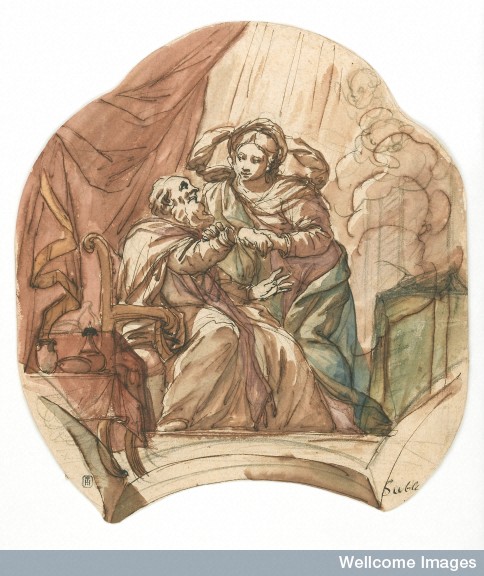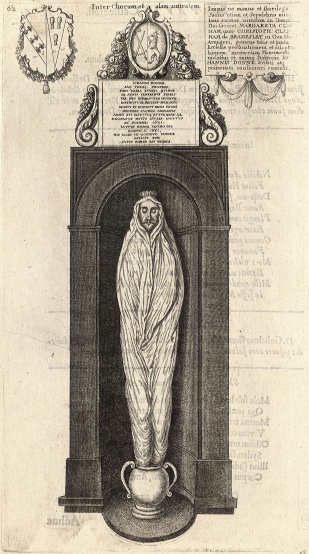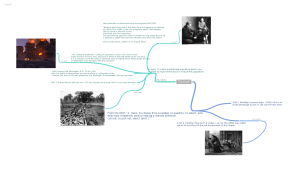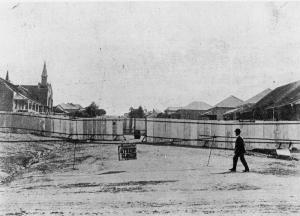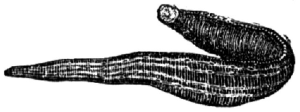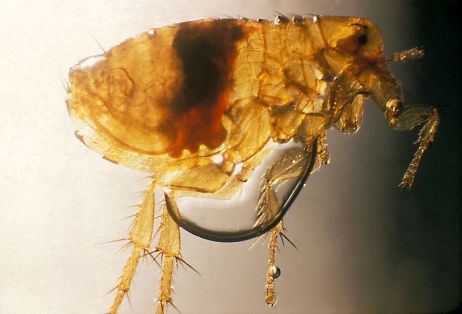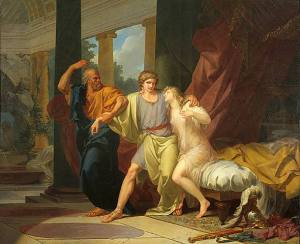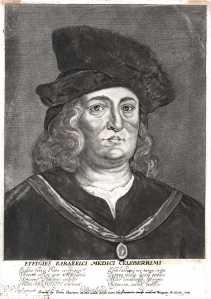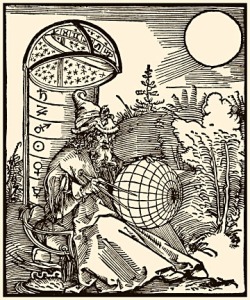This is an excerpt from a page in progress on John Donne from my dissertation. Any thoughts on the Latin version would be appreciated; let me know if you want the original posted.
At one point in his life Donne lent a book to a friend of his, “Dr. Andrews,” whose children proceeded to tear it to pieces. It was afterwards “returned in manuscript,” implying that the doctor had taken the time to copy the printed book by hand as an apology for the mishap. The poem, which is both poignant and rich in its insights pertaining to the soulfulness of the manuscript versus the soullessness of the book, is worth quoting in full:
Damp from the press is born the current book,
But manuscripts wear a more reverent look.
To the Seine Mœnus passed, to Louis’ home,
From thence to Frankfort, in thy hands to roam.
The book which, dyed with printer’s ink, is thrust
On shelves abandoned to the moths and dust,
If writ with pen it reach us, is respected,
And straight in ancient father’s chests protected.
Apollo must explain how boys can pour
On a new book long years and aspect hoar.
No wonder that a doctor’s sons we see
Able to give new book new destiny.
If boys make old the recent, their sire’s art
To me an old man may new youth impart.
Ah, poor old men! harsh age turns us, forsooth,
To thy second childhood all, ne’er one to youth.
Tis Thy prerogative, Ancient of Days,
With life and youth to crown who on Thee gaze.
The weariness of this frail life meanwhile
With books and love heaven-during we beguile;
Mid which that little book thou dost restore
Ne’er was so dear, so much my own, before.
Grosart’s translation, while witty in its rhyme scheme, nevertheless lacks the visceral charge of Donne’s original Latin verse. Although it was not unusual for Donne to write in Latin, his choice of languages seems more appropriate for a poem written from a man of the church to a man of medicine. Latin would have carried a special relevance in terms of their vocations, and either person would have appreciated the layered, etymological resonance behind Donne’s words which were inextricably tied to the hermeneutics of the body. Naturally, then, the poem begins with a birth.
The newborn book arrives “damp from the press, “comparing the wet ink of the printing press stickiness of the infant.[1] Grosart’s periodic syntax places less emphasis on the birth itself, instead drawing attention to the book’s emergent, unformed state. Donne’s Latin “Parturiunt,” on the other hand, evokes the act of labor, with “madido” emphasizing the soaking or saturated quality of the paper. The description would almost seem to validate the effort of the press as a labor of love, except that the printed book is quickly relegated to the shelves soon after its arrival in the world, “abandoned to the moths and dust.”[2] By omitting the narrative of the manuscript’s birth, the latter’s creation has the sense of being immaculate– holy in its effortlessness.
As is befitting a sacred text, it also wears a “more reverent look,” destined for travel and circulation from the Seine to Frankfurt. H.W. Garrod lends an intriguing reading of Donne’s references to the river, translating them as: “The Maine has become tributary to the Seine; brought back the captive of your triumph, even Frankfurt passes to the halls of its conquerer” (40). The reference to Frankfurt, according to his interpretation, is a reference to Gutenberg’s home and thus to the birth of the printed book: “When Dr. Andrews replaced a printed book by a manuscript worthy to stand with the manuscripts of the Fathers of the church, he undid (Donne would have him believe) the work of Gutenberg, he beat the printers, he won victory confessed over all sellers of printed books” (41). Although a consensus on the meaning of these lines will likely remain elusive, even the lay-reader can intuit the sense of liberated mobility afforded to the handwritten book compared to its static counterpart.
At this point Donne throws in a little bit of comic relief, joking that boys have seemingly rewritten the book’s “new destiny” by having torn it apart. It stands to reason that their father was a physician. Unfortunately for Donne the boys have little power to transform his own destiny, unlike that of the book. The irony, in fact, is that books themselves represent a temporary “stay” against the confusion of old age― “with books and love” we distract ourselves from our “frail life.” As the single earthly artifact capable of being restored/corrected, Donne cherishes it: “Ne’er was so dear, so much my own, before.” Thus, it is only through the painstakingly personal labor of handwriting which restores the book to its owner in an even more beloved state.
Overall, the poem is a lighthearted one– meant to reassure a friend who was guilt-ridden enough by his children’s actions to complete re-write a desecrated volume by hand. On the other hand, it also sheds light on the complex, triadic relationship between the textual body as a circulating, translated, and evolving entity. In this case the book experiences the restoration of its youth and even a form of resurrection– opportunities which are not readily afforded to its mortal reader. As Garrod observes, Donne was feeling poorly during his time in Paris, which is likely when this poem was written (41). Perhaps the presence of this stubborn illness kept him grounded, unable to experience the transitory freedom of his book. If this were the case, it offers a more sentimental reading of the final lines, in which Donne’s book is restored to him, more dear than before; his Latin “redditus” denotes the act of renting, reciprocation, or return. Although Grosart’s translation properly conveys the restorative quality of the doctor’s rewrite, the original poem perhaps possesses a tinge of gladness for the book’s voluntary return after its extensive circulation.
[1] The word “præla” ostensibly refers to a printing press, although it could arguably mean a press of any type (such as a wine press or olive press). The press served as an important metaphor for Augustine, who described the “olive press of the Lord our God” as a means of separating under pressure the “oil of believers” from the “murmuring and blasphemy” of unbelievers (“Letter 111.2”). In Expostulation V from his Devotions Upon Emergent Occasions, Donne compares his solitude to that of Christ, quoting Isaiah LXIII.3: It was for thy blessed, thy powerful Son alone, to tread the wine-press alone, and none of the people with him.”
[2] The Latin mentions “blattis,” meaning cockroach, in lieu of “moths,” implying that the book is decaying in death rather than simply disintegrating out of neglect.
